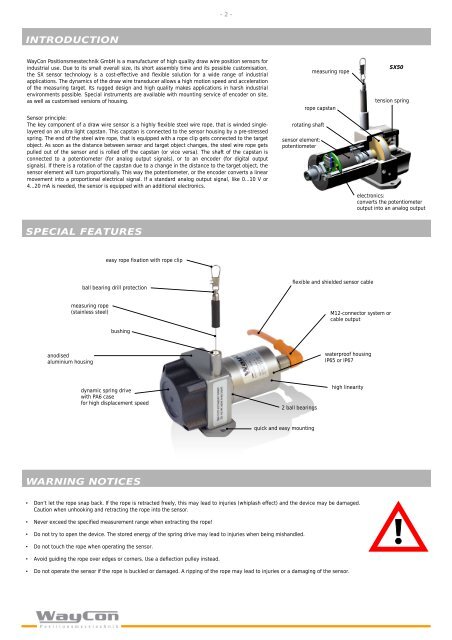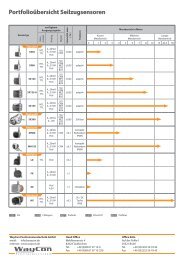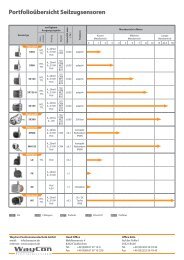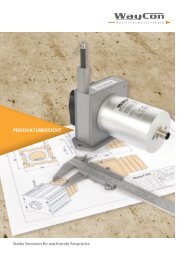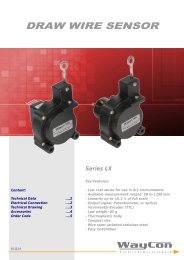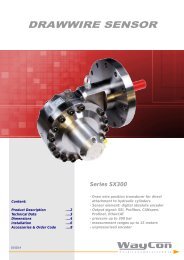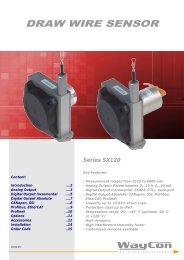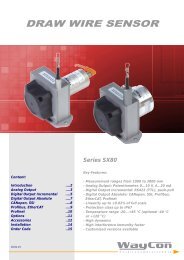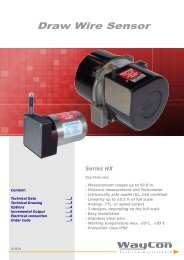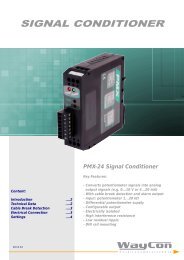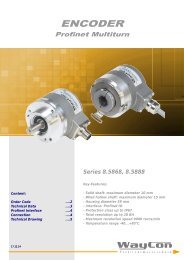DRAW WIRE SENSOR SX50
- Measurement ranges 50 mm up to 1250 mm - Analog Output: Potentiometer, 0...10 V, 4...20 mA - Digital Output Incremental: RS422 (TTL), Push-Pull - Digital Output Absolute: CANopen, SSI - Linearity up to ±0.02% of full scale - Protection class up to IP67 - Temperature range: -20...+85 °C (optional -40 °C or +120 °C) - High dynamics - High interference immunity factor - Customised versions available
- Measurement ranges 50 mm up to 1250 mm
-
Analog
Output: Potentiometer, 0...10 V, 4...20 mA
- Digital Output Incremental: RS422 (TTL), Push-Pull
- Digital Output Absolute: CANopen, SSI
- Linearity up to ±0.02% of full scale
- Protection class up to IP67
- Temperature range: -20...+85 °C (optional -40 °C
or +120 °C)
- High dynamics
- High interference immunity factor
- Customised versions available
You also want an ePaper? Increase the reach of your titles
YUMPU automatically turns print PDFs into web optimized ePapers that Google loves.
- 2 -<br />
INTRODUCTION<br />
WayCon Positionsmesstechnik GmbH is a manufacturer of high quality draw wire position sensors for<br />
industrial use. Due to its small overall size, its short assembly time and its possible customisation,<br />
the SX sensor technology is a cost-effective and flexible solution for a wide range of industrial<br />
applications. The dynamics of the draw wire transducer allows a high motion speed and acceleration<br />
of the measuring target. Its rugged design and high quality makes applications in harsh industrial<br />
environments possible. Special instruments are available with mounting service of encoder on site,<br />
as well as customised versions of housing.<br />
Sensor principle:<br />
The key component of a draw wire sensor is a highly flexible steel wire rope, that is winded singlelayered<br />
on an ultra light capstan. This capstan is connected to the sensor housing by a pre-stressed<br />
spring. The end of the steel wire rope, that is equipped with a rope clip gets connected to the target<br />
object. As soon as the distance between sensor and target object changes, the steel wire rope gets<br />
pulled out of the sensor and is rolled off the capstan (or vice versa). The shaft of the capstan is<br />
connected to a potentiometer (for analog output signals), or to an encoder (for digital output<br />
signals). If there is a rotation of the capstan due to a change in the distance to the target object, the<br />
sensor element will turn proportionally. This way the potentiometer, or the encoder converts a linear<br />
movement into a proportional electrical signal. If a standard analog output signal, like 0...10 V or<br />
4...20 mA is needed, the sensor is equipped with an additional electronics.<br />
rotating shaft<br />
sensor element:<br />
potentiometer<br />
measuring rope<br />
rope capstan<br />
<strong>SX50</strong><br />
tension spring<br />
electronics:<br />
converts the potentiometer<br />
output into an analog output<br />
SPECIAL FEATURES<br />
easy rope fixation with rope clip<br />
ball bearing drill protection<br />
flexible and shielded sensor cable<br />
measuring rope<br />
(stainless steel)<br />
M12-connector system or<br />
cable output<br />
bushing<br />
anodised<br />
aluminium housing<br />
waterproof housing<br />
IP65 or IP67<br />
dynamic spring drive<br />
with PA6 case<br />
for high displacement speed<br />
2 ball bearings<br />
high linearity<br />
quick and easy mounting<br />
WARNING NOTICES<br />
• Don‘t let the rope snap back. If the rope is retracted freely, this may lead to injuries (whiplash effect) and the device may be damaged.<br />
Caution when unhooking and retracting the rope into the sensor.<br />
• Never exceed the specified measurement range when extracting the rope!<br />
• Do not try to open the device. The stored energy of the spring drive may lead to injuries when being mishandled.<br />
• Do not touch the rope when operating the sensor.<br />
• Avoid guiding the rope over edges or corners. Use a deflection pulley instead.<br />
• Do not operate the sensor if the rope is buckled or damaged. A ripping of the rope may lead to injuries or a damaging of the sensor.


